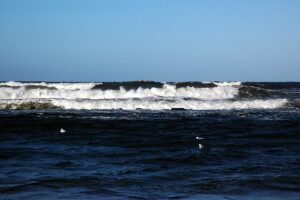Water shortages are affecting the better part of Europe. Poland is also facing droughts with increased frequency. This problem poses a huge threat to farming, as well as everyday life. Crimea has had the same issue for over a dozen years and it is becoming more and more severe – writes Mariusz Marszałkowski, editor at BiznesAlert.pl.
Water is precious for Crimea
Before Russia’s illegal annexation of Crimea in 2014, the peninsula received 85% of its water from the Dnieper river via the North Crimean Canal. After the annexation, Ukraine stopped water deliveries to the peninsula. This decision caused panic among occupation authorities. To rectify the situation Russian army’s engineer units built a number of water installations. Their main section was a water pipeline from water reservoirs in Belogorsk and Taigan. The water ran from the reservoirs via the Biuk-Karasu river to an artificial water tank in Novoivanovce, at which point it fell into the North Crimean Canal to supply the people of, among others, Kerch and to provide water to rural areas in northern Crimea.
Additionally, in the vicinity of Dzhankoi and Nizhnegorskiy a few artesian water inlets that provided water to over 36 wells were drilled. They were to deliver 200 thousand cubic meters of water a day to over 400 thousand people. The goal of these actions was to ensure enough water for Crimea’s inhabitants’ basic needs.
Water shortages
The initial issues with water appeared back in 2018. The drying up of the Biuk-Karasu region’s main river became the symbol of the peninsula’s environmental tragedy. It also turned out that drilling for artesian wells significantly lowered Crimea’s ground water levels and caused soil salinity. The situation is getting worse.
Because the last winter was warm and dry, there was no snow that would naturally provide water to the southern region of Crimea. Spring rain also failed to appear. According to data of the Commission On Water Economy and Melioration of the Crimea Republic, water reservoirs that supply the peninsula’s southern towns are not sufficiently filled. In mid-April the Frontove reservoir that supplies water to Theodosia and Crimea was filled at 4.2%, the Bakhchysarai reservoir at 22.9%, the Simferopol reservoir at 29%, the Chernorechye reservoir, which supplies Sevastopol, at 51%.
The lack of rain only exacerbates this crisis. In April the precipitation in Crimea was at about 25% of the multiyear average, according to data by the Hydro-Meteorological Center. Consequently, as of 15 May the authorities were forced to impose limits on providing water to Crimea inhabitants.
The official data says that the Crimea Republic increased its number of inhabitants by 20 thousand as of 2015, whereas Sevastopol itself (as a separate entity) by 50 thousand. The majority of those people are professional soldiers and officers of Russia’s security apparatus. The water supply had been insufficient before the newcomers came and their arrival only made matters worse.
Solutions for Crimea
There are only two ways out of this hydrological predicament. The first one is for Ukraine to reopen the North Crimean Canal. However, the Ukrainian society is against this, including the inhabitants of the Khersonsky district. Recently rumors about an agreement between Russia and Ukraine about restarting water supply to Crimea flew about. Some time ago Russia wanted to include this postulate in the negotiations on the Minsk agreement. However, the consent to restore water supply to Crimea would tarnish the image of the government in Kiev, which would have to face protests. A „quiet” privatization of a section of the Canal could be a solution, but it would require a multimillion investment. It is apparent that the existing infrastructure on the Ukrainian and Russian sides is in extremely bad technical shape. Pictures reveal its advanced decay.
The second solution is to bring torrential rain to Crimea. However, this is not doable even for the Russian state. Much to Moscow’s dismay climate changes are going completely against its interests. Every year the level of precipitation on the peninsula is lower. The traditional winter is being replaced with warm periods with little rain. There have been talks in Russia on constructing a water pipeline that would start in the Kuban region. However, this area has been also affected by the drought in the recent years, so exporting its water to Crimea could be socially and economically detrimental.
Recapitulation
Water shortages in Crimea are becoming increasingly harmful despite all the actions taken by the Russian authorities. The number of empty reservoirs that hold water that is running down from the mountains in the southern part of the peninsula is growing. The number of rivers in Crimea that are drying up is growing and the large-scale well drilling is not fulfilling its end purpose, instead causing soil salinity and erosion. Crimea is an important tourist destination for Russia. It is heavily promoted by the government, which encourages people to go there as it is now Russia’s territory. The issues with water are not encouraging to prospective tourists despite the fact that Moscow has invested a lot to make Crimea a center of Russian tourism. This means Crimea’s problem has become a federal issue. The two million people who live in this grassland region will want the government in Moscow to pay more attention to them. So far, billions of rubles have been spent on investments to purify and store water. However, if this money doesn’t help, Crimea’s powerlessness may reveal itself in two ways: either as an attempt at striking an agreement with Kiev, or as an attempt at using the military to acquire new areas, from which Russia could restart water supply to the peninsula. Neither of these solutions will be welcome by the government in Kiev.








